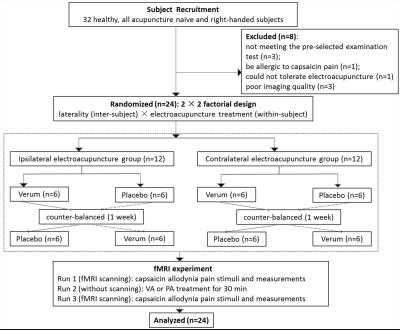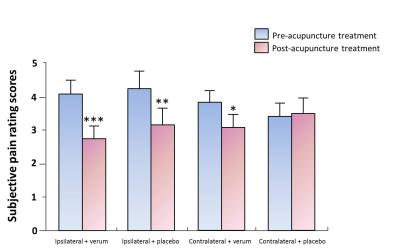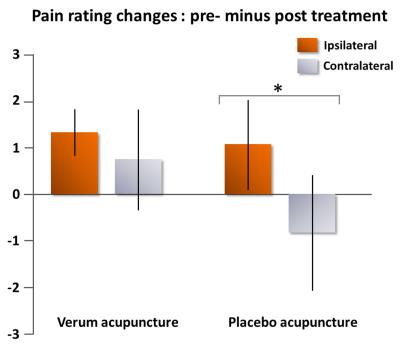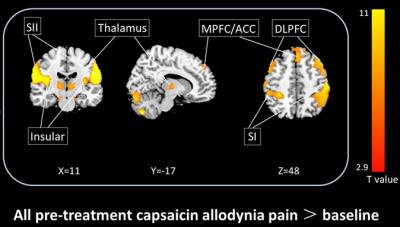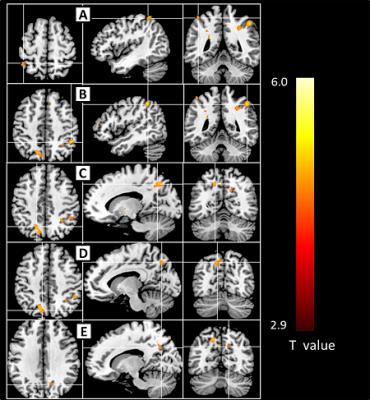5408
Investigation of neural mechanism underlying ipsi- and contra-lateral acupuncture analgesia in the capsaicin-induced pain model1The First Affiliated Hospital of Xi’An Jiaotong University, Xi’an, People's Republic of China, 2The Key Laboratory of Biomedical Information Engineering,Ministry of Education, Department of Biomedical Engineering, School of Life Science and Technology, Xi’an Jiaotong University, Xi’an, People's Republic of China
Synopsis
This paper presents an original research to investigate the underlying neural mechanism on analgesia at ipsi- or contra-lateral acupuncture with capsaicin-induced allodynia on human body. Our findings further suggested that DMN participants in the modulation of spatial-oriented attention on placebo analgesia as a mechanism underlying the degree to which treatment side corresponding to the pain. Notably, disruptions of the DMN may account for the cognitive and behavioral impairments in chronic pain patients. In addition, it may possibly reflect individual variation in placebo response, thus, as a valuable neural biomarker to predict clinical curative effect in acupuncture treatment.
Purpose:
Acupuncture application side, ipsi- or contra-lateral side to the pain site, plays an important role in reaching its better analgesic treatment effect. However, the involving brain mechanism still remains unclear. Compared to heat pain model widely established in previous studies, capsaicin pain model induces reversible cutaneous allodynia and is proved to be better simulating aspects of clinical nociceptive and neuropathic pain. The current study aimed to investigate the differential neural mechanism underlying acupuncture stimulating at locations ipsilateral and contralateral to pain sites using capsaicin-induced allodynia as a pain model on human body.Methods and Materials:
Twenty- four subjects were randomly divided into two groups with a 2 × 2 factorial design: laterality (inter-subject) × verum or placebo acupuncture treatment (within-subject), counter-balanced at an interval of one week. A topical application of capsaicin cream to left forearm was used to elicit allodynia. In the present study, we observed subjective pain intensity levels (pain sensory ratings) and brain activations changes induced by capsaicin allodynia pain stimuli before and after acupuncture treatment at LI4 for 30 mins.Results:
Both ipsi- and contra-lateral verum acupuncture (VA) reduced the subjective pain ratings (P<0.01), while ipsilateral verum acupuncture showed prominently greater pain attenuations, compared with that of the contralateral side. In contrast, significant pain reductions emerged after placebo acupuncture (PA) only on the ipsilateral side (P<0.05), but not on the contralateral side. Analysis of variance results indicated that ipsilateral electroacupuncture treatment produced significant pain relief and wide brain signal suppressions in pain-related brain areas compared with contralateral electroacupuncture. We also found that verum electroacupuncture at either ipsi- or contra-lateral side to the pain site exhibited comparable significant magnitudes of analgesic effect. By contrast, placebo electroacupuncture elicited significant pain reductions only on the ipsi- rather than contra-lateral side. It was inferred that placebo analgesia maybe attenuated on the region of the body (opposite to pain site) where attention was less focused, suggesting that analgesic effect of placebo electroacupuncture mainly rely on the motivation of its spatial-specific placebo responses via attention mechanism. This inference can be further supported by the evidence that the significant interaction effect of manipulation laterality and treatment was exclusively located within the default mode network, including the bilateral superior parietal lobule, inferior parietal lobule, precuneus and left posterior cingulate cortex.Conclusions:
It is also proved that disruptions of the default mode network may account for the cognitive and behavioral impairments in chronic pain patients. Our findings further suggested that default mode network participates in the modulation of spatial-oriented attention on placebo analgesia as a mechanism underlying the degree to which treatment side corresponding to the pain.Acknowledgements
This study was supported by the National Natural Science Foundation of China (Project Nos. 81371630, 81571752, 81227901, 81571640 and 81371530), the Shaanxi Nova program, the Fundamental Research Funds for the Central Universities.References
1. Kong J, Kaptchuk TJ, Polich G, et al. Expectancy and treatment interactions: a dissociation between acupuncture analgesia and expectancy evoked placebo analgesia. NeuroImage. 2009;45(3):940-949.
2. Ritter C, Hebart MN, Wolbers T, Bingel U. Representation of spatial information in key areas of the descending pain modulatory system. The Journal of neuroscience : the official journal of the Society for Neuroscience. 2014;34(13):4634-4639.
3. Rollman GB, Harris G. The detectability, discriminability, and perceived magnitude of painful electrical shock. Perception & psychophysics. 1987;42(3):257-268.
4. Bai L, Tian J, Zhong C, et al. Acupuncture modulates temporal neural responses in wide brain networks: evidence from fMRI study. Molecular pain. 2010;6:73.
5. Kucyi A, Salomons TV, Davis KD. Mind wandering away from pain dynamically engages antinociceptive and default mode brain networks. Proceedings of the National Academy of Sciences of the United States of America. 2013;110(46):18692-18697.
Figures
